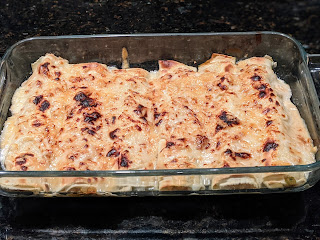I've made this with chicken and lamb, and have tweaked the spices, quantities, and procedure slightly. If using lamb, be careful that the rich sauce and spices doesn't overpower the mild flavor of the meat. This is a very rich dish and will feed about 8 with the proportions given. 1.5 hours cooking time
 |
Fesenjan served with basmati tahdig
|
Adapted from a recipe posted by Emma Fernlund (thanisa@df.lth.se), from Persian Cooking: A Table of Exotic Delights, by Nesta Ramazani 1974, ISBN 0-8139-0962-7.
Serves: 8
2 large Onions, chopped or sliced
5 Tbsp Butter
2.5 pound Chicken or Lamb, cut into 1-inch cubes
2 cup Chicken, Lamb, or Veal Stock
2 1/2 cups Walnuts, ground: some fine, some corn-kernel size
1 cup Water
4.5 Tbs Pomegranate Syrup (substitute sour cranberry juice)
2-3 Tbsp Sugar
2-3 tsp Salt
1/2 tsp Saffron (or turmeric)
1/4 tsp Cinnamon (ground from stick instead of pre-ground)
1/4 tsp Nutmeg
1/4 tsp Pepper
2 Tbsp Lemon juice
6 pods Cardamom, ground
3 Cloves, ground
Saute the onions in 2 Tbsp of the butter until golden brown.
Remove from the pan.
Add 3 more Tbsp of butter and saute the chicken/lamb pieces until lightly browned.
Drain fat.
Add the Stock and sauteed onions.
Cover and simmer gently for 30 minutes.
Bone if needed.
While that's cooking...
Grind the Walnuts to a mix of sizes; the texture too thick if ground uniformly fine.
Toast the ground walnuts in a saucepan or skillet until aromatic.
Prepare the sauce by stirring the water into the ground walnuts.
Stir in the pomegranate syrup and sugar, and simmer gently over a low heat for 10-15 minutes.
 |
| Roughly grind the walnuts |
Add the walnut sauce to the cooked, chicken/lamb and onions.
Add the seasonings and the lemon juice.
Cover and simmer gently for another hour.
Adjust the seasonings by adding a little sugar if too sour, or more pomegranate syrup if too sweet.
The chicken/lamb pieces should be coated with a rich, dark, sweet-sour sauce; there should be plenty of thick sauce.
Serve with rice, preferably
Tahdig. Couscous also works well, as would unleavened bread.
 |
| Basmati rice tahdig |















